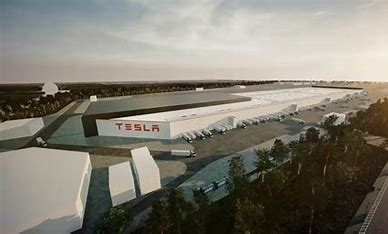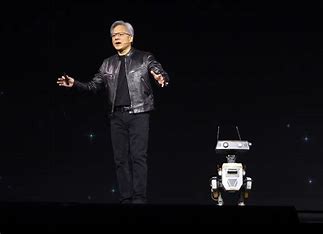4 Things Industry 4.0 - Mar. 24th, 2025

Presented by

Good morning. Yesterday may have been the first Sunday of spring, but tech and manufacturing news didn’t stop to smell the flowers.
In this edition, we’re diving into Nvidia’s Disney-fueled robot reveal, Johnson & Johnson's staggering U.S. investment plans, and how TerraPower’s next-gen nuclear tech could change the energy game. Plus, Ford’s under the microscope (again), and Boston Dynamics reminded everyone that robots can still out-cartwheel most of us.
Let’s get into it.
Tesla Announces New Megapack Factory in Texas

Tesla is expanding its energy storage production with a new Megapack manufacturing facility in Brookshire, Texas, approximately 40 miles west of Houston. The 1 million-square-foot plant aims to bolster the company's capacity to produce large-scale battery storage units, which are essential for stabilizing power grids and supporting renewable energy integration. The project is expected to create around 1,500 jobs over three years, with Tesla investing $44 million in facility improvements and $150 million in manufacturing equipment. This marks Tesla's third Megapack factory, following facilities in California and Shanghai, reinforcing the growing demand for energy storage solutions amid the global shift toward clean energy.
Johnson & Johnson Commits Over $55 Billion to U.S. Expansion

Johnson & Johnson has announced plans to invest more than $55 billion in the United States over the next four years, marking a 25% increase compared to the previous four years. This substantial investment includes the construction of four new manufacturing facilities, starting with a high-tech plant in Wilson, North Carolina, which is expected to create over 500 jobs. The initiative aims to enhance the company's manufacturing capabilities, research and development infrastructure, and technological advancements, showing a strong commitment to bolstering domestic operations.
Nvidia Unveils 'Blue' Robot in Collaboration with Disney and Google

At GTC 2025, Nvidia CEO Jensen Huang introduced "Blue," a 3-foot-tall, AI-powered robot developed with Disney Research and Google DeepMind. Resembling a character from Pixar's "WALL-E," Blue demonstrated lifelike movements and interactive capabilities on stage. The robot operates using Nvidia's new Newton physics engine, designed to enhance robotic movement and learning by improving precision in simulations and real-world interactions. Disney plans to showcase Blue at its theme parks, including Walt Disney World and Disneyland Paris, this summer.
Sponsor Message

You Can Still Join the Mastermind 12-Week Accelerator Program
Embark on a transformative journey with our 12-week Digital Factory Mastermind Accelerator Program. Gain expert insights, practical tools, and personalized coaching to revolutionize your approach to digital transformation. Watch the video below from Zack Scriven, our group facilitator, and digital transformation coach, to learn more.
Dates: Begins March, 11th
10:00AM Central
For more details, visit the 12-Week Mastermind Accelerator Program.
Ford F-150 Trucks Under Federal Investigation for Sudden Downshifts

The National Highway Traffic Safety Administration (NHTSA) has initiated an investigation into approximately 1.3 million Ford F-150 pickup trucks from model years 2015 to 2017. This action follows 138 consumer complaints alleging unexpected downshifts to lower gears at high speeds, leading to rapid deceleration and potential rear-wheel lockup, thereby increasing the risk of crashes. Ford has acknowledged the issue, attributing it to the trucks' six-speed transmissions, and is cooperating with the NHTSA's inquiry. Notably, there have been no reports of crashes or injuries related to this problem.
Industry 4.0 Highlights
Intel's Technology Development Chief Announces Retirement Amid Leadership Restructuring
Intel's Executive Vice President, Dr. Ann Kelleher, who has led the company's process technology development since 2020, plans to retire later this year after over three decades with the company. In preparation for this transition, Intel has appointed Naga Chandrasekaran, formerly of Micron, to oversee front-end process technology development and manufacturing. Additionally, Navid Shahriari will lead a newly formed organization focusing on back-end operations, including advanced packaging and assembly test manufacturing. These leadership changes come as Intel advances its 18A process technology, aiming to strengthen its position in semiconductor manufacturing.
TerraPower on Track to Launch Next-Gen Nuclear Plant by 2030
TerraPower, the nuclear energy company founded by Bill Gates, is progressing ahead of schedule in developing its inaugural small modular reactor near a retiring coal plant in Wyoming. CEO Chris Levesque announced that the company aims to commence electricity production by 2030 and plans to have approximately 10 to 12 additional plants under construction by that time. This initiative positions TerraPower to potentially deploy the first next-generation nuclear technology in the U.S., bolstered by a $2 billion investment from the U.S. Department of Energy and $1 billion from Gates. The growing demand for clean, continuous power, especially from large data centers, underscores the significance of this advancement in nuclear energy.
Learning Lens

Docker Swarm vs. Kubernetes – Orchestrating Containers Your Way
When it comes to container orchestration, Docker Swarm and Kubernetes offer two distinct approaches. Docker Swarm is simpler to set up and ideal for small-to-medium workloads, providing fast deployments and tight Docker integration. Kubernetes, on the other hand, is more powerful and scalable, featuring advanced capabilities like auto-scaling, self-healing, and extensive ecosystem support—making it the go-to for enterprise-level applications. The choice comes down to simplicity versus sophistication, with Kubernetes offering greater flexibility and control at the cost of complexity.
Learn more: Docker Swarm vs. Kubernetes
Byte-Sized Brilliance
Industrial Robots Get More Flexible—Literally
Robots on factory floors used to be massive, rigid machines locked behind safety cages. Now? Soft robotics are flipping the script. Made from flexible materials and inspired by biology (think octopus arms or elephant trunks), these bots can handle delicate items like food or electronics without crushing them. The next wave of automation isn’t just smart—it’s squishy.
We Value your Feedback.
Click on the link below to provide us with your thoughts.
|
|
|
|
|
|
4.0 Solutions Newsletter
4 Things Industry 4.0 - Weekly Insights in the Manufacturing Industry


Responses